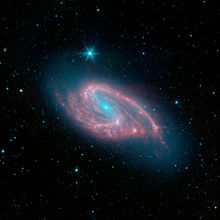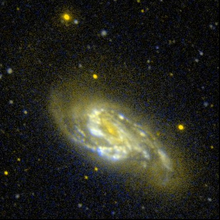Messier 66
 From Wikipedia - Reading time: 8 min
From Wikipedia - Reading time: 8 min
| Messier 66 | |
|---|---|
 A colour-composite image of M66 | |
| Observation data (J2000 epoch) | |
| Constellation | Leo |
| Right ascension | 11h 20m 15.026s[1] |
| Declination | +12° 59′ 28.64″[1] |
| Redshift | 0.002425±0.000010[2] (696.3±12.7 km/s)[3] |
| Distance | 31 Mly (9.6 Mpc)[4] |
| Apparent magnitude (V) | 8.9[2] |
| Characteristics | |
| Type | SAB(s)b[5] |
| Apparent size (V) | 9.1′ × 4.2′[6] |
| Notable features | Galaxy in the Leo Triplet |
| Other designations | |
| Arp 16, NGC 3627, PGC 34695, UGC 6346[7] | |
Messier 66 or M66, also known as NGC 3627, is an intermediate spiral galaxy in the southern, equatorial half of Leo. It was discovered by French astronomer Charles Messier[8] on 1 March 1780, who described it as "very long and very faint".[9] This galaxy is a member of a small group of galaxies that includes M65 and NGC 3628, known as the Leo Triplet or the M66 Group.[10] M65 and M66 are a common object for amateur astronomic observation, being separated by only 20′.[9]
M66 has a morphological classification of SABb,[5] indicating a spiral shape with a weak bar feature and loosely wound arms. The isophotal axis ratio is 0.32, indicating that it is being viewed at an angle.[5] M66 is receding from us with a heliocentric radial velocity of 696.3±12.7 km/s.[3] It lies 31[4] million light-years away and is about 95 thousand light-years across[11] with striking dust lanes and bright star clusters along sweeping spiral arms.
Five supernovae have been observed in M66: SN 1973R (type IIP, mag. 14.5),[12] SN 1989B (type Ia, mag. 13),[13] SN 1997bs (Type IIn or LBV,[14] mag. 17),[15] SN 2009hd (Type II, mag. 15.8),[16] and SN 2016cok (Type IIP, mag. 16.6).[17][18][19] SN 2016cok was discovered by the All Sky Automated Survey for Supernovae.[20]
Gravitational interaction from its past encounter with neighboring NGC 3628 has resulted in an extremely high central mass concentration; a high molecular to atomic mass ratio; and a resolved non-rotating clump of H I material apparently removed from one of the spiral arms. The latter feature shows up visually as an extremely prominent and unusual spiral arm and dust lane structures as originally noted in the Atlas of Peculiar Galaxies.[21]
Gallery
[edit]-
Infrared false color view of M66 from the Spitzer Space Telescope
-
Infrared false color view of M66 from the James Webb Space Telescope
-
Messier 66 by 2MASS
-
An ultraviolet image of Messier 66 by GALEX
See also
[edit]References
[edit]- ^ a b Skrutskie, Michael F.; Cutri, Roc M.; Stiening, Rae; Weinberg, Martin D.; Schneider, Stephen E.; Carpenter, John M.; Beichman, Charles A.; Capps, Richard W.; Chester, Thomas; Elias, Jonathan H.; Huchra, John P.; Liebert, James W.; Lonsdale, Carol J.; Monet, David G.; Price, Stephan; Seitzer, Patrick; Jarrett, Thomas H.; Kirkpatrick, J. Davy; Gizis, John E.; Howard, Elizabeth V.; Evans, Tracey E.; Fowler, John W.; Fullmer, Linda; Hurt, Robert L.; Light, Robert M.; Kopan, Eugene L.; Marsh, Kenneth A.; McCallon, Howard L.; Tam, Robert; Van Dyk, Schuyler D.; Wheelock, Sherry L. (1 February 2006). "The Two Micron All Sky Survey (2MASS)". The Astronomical Journal. 131 (2): 1163–1183. Bibcode:2006AJ....131.1163S. doi:10.1086/498708. ISSN 0004-6256. S2CID 18913331.
- ^ a b de Vaucouleurs, G.; et al. (1991), Third reference catalogue of bright galaxies, 9, New York: Springer-Verlag.
- ^ a b van den Bosch, Remco C. E.; et al. (May 2015), "Hunting for Supermassive Black Holes in Nearby Galaxies With the Hobby-Eberly Telescope", The Astrophysical Journal Supplement Series, 218 (1): 13, arXiv:1502.00632, Bibcode:2015ApJS..218...10V, doi:10.1088/0067-0049/218/1/10, S2CID 117876537, 10.
- ^ a b Tully, R. Brent; et al. (August 2016), "Cosmicflows-3", The Astronomical Journal, 152 (2): 21, arXiv:1605.01765, Bibcode:2016AJ....152...50T, doi:10.3847/0004-6256/152/2/50, S2CID 250737862, 50.
- ^ a b c Ann, H. B.; et al. (2015), "A Catalog of Visually Classified Galaxies in the Local (z ~ 0.01) Universe", The Astrophysical Journal Supplement Series, 217 (2): 27–49, arXiv:1502.03545, Bibcode:2015ApJS..217...27A, doi:10.1088/0067-0049/217/2/27, S2CID 119253507.
- ^ "NASA/IPAC Extragalactic Database", Results for NGC 3627, retrieved 31 August 2006.
- ^ "NGC 3627". SIMBAD. Centre de données astronomiques de Strasbourg. Retrieved 2 December 2018.
- ^ Frommert, Hartmut; Kronberg, Christine (15 June 2016), Spiral Galaxy M66, retrieved 3 December 2018.
- ^ a b O'Meara, Stephen James (2014), Deep-Sky Companions: The Messier Objects, Cambridge University Press, p. 248, ISBN 978-1107018372 It is recorded as discovered by Pierre Méchain, but apparently this is an error.
- ^ Adam, Len (2018), Imaging the Messier Objects Remotely from Your Laptop, The Patrick Moore Practical Astronomy Series, Springer, p. 290, Bibcode:2018imor.book.....A, ISBN 978-3319653853
- ^ Per the small angle formula: 31 mly × tan( 9.1′ ) = ~82 kly. diameter
- ^ Transient Name Server entry for SN 1973R. Retrieved 24 March 2023.
- ^ Transient Name Server entry for SN 1989B. Retrieved 24 March 2023.
- ^ Van Dyk, Schuyler D.; Peng, Chien Y.; King, Jennifer Y.; Filippenko, Alexei V.; Richards, R. R.; Li, Weidong; Richmond, Michael W. (2000). "SN 1997bs in M66: Another Extragalactic η Carinae Analog?". Publications of the Astronomical Society of the Pacific. 112 (778): 1532–1541. arXiv:astro-ph/0009027. doi:10.1086/317727.
- ^ Transient Name Server entry for SN 1997bs. Retrieved 24 March 2023.
- ^ Transient Name Server entry for SN 2009hd. Retrieved 24 March 2023.
- ^ Sutaria, Firoza; Ray, Alak (June 2016), "No X-ray detection of SN2016cok by Swift XRT", The Astronomer's Telegram, 9189: 1, Bibcode:2016ATel.9189....1S.
- ^ List of Supernovae, Central Bureau for Astronomical Telegrams, retrieved 9 September 2015
- ^ Transient Name Server entry for SN 2016cok. Retrieved 24 March 2023.
- ^ Lewis, Danny. "Spy Two Supernovae in June's Night Sky". Smithsonian. Retrieved 22 November 2019.
- ^ Zhang, Xiaolei; et al. (1993), "High-Resolution CO and H i Observations of the Interacting Galaxy NGC 3627", Astrophysical Journal, 418: 100, Bibcode:1993ApJ...418..100Z, doi:10.1086/173374.
External links
[edit]- Spiral Galaxy M66
- Astronomy Picture of the Day – Unusual Spiral Galaxy M66 from Hubble – 2010 April 13
- Messier 66 Close Up, APOD June 13, 2024
- Merrifield, Mike; Szymanek, Nik. "M66 – Spiral Galaxy". Deep Sky Videos. Brady Haran.
- Messier 66 on WikiSky: DSS2, SDSS, GALEX, IRAS, Hydrogen α, X-Ray, Astrophoto, Sky Map, Articles and images
 KSF
KSF



